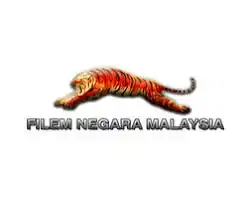Filem Negara Malaysia
The National Film Department of Malaysia (Malay: Filem Negara Malaysia), abbreviated FNM, sometime Jabatan Filem Negara (JFN); was a government department under the Malaysian Ministry of Communications and Multimedia, which was responsible for the filming and documentation of national events.[1] Its headquarters were located in Petaling Jaya, Selangor.
| Filem Negara Malaysia (FNM) Jabatan Filem Negara (JFN) | |
 | |
| Executive agency overview | |
|---|---|
| Formed | 1 April 1946 |
| Preceding Executive agency |
|
| Dissolved | 2012 |
| Superseding agency |
|
| Headquarters | Jalan Utara, Petaling Jaya, Selangor, Malaysia |
| Parent department | Ministry of Information, Communication and Culture |
| Website | www |
Among the main functions of FNM was to spread the information about the policy, programme and achievement of the government and to promote the country through the films produced. Other than that, FNM was tasked to produce high quality documentary film and trailer to supply to customers. FNM was to be the official government film producing organisation with the high international level.
In 2012, Filem Negara Malaysia was merged with the National Film Development Corporation Malaysia (FINAS) to form a single agency.[2]
History
Prior to 22 November 1963, the National Film Department (NFD) was known as the Malayan Film Unit. The Malayan Film Unit started its operations in April 1946 and was based in Jalan Bangsar, Kuala Lumpur. It was a unit under the National Communications Department (Jabatan Perhubungan Raya), thereafter known as the Department of Information.
The present National Film Department complex is situated at Jalan Utara, Petaling Jaya. It was officiated by the third Yang di-Pertuan Agong, Al-Marhum Tuanku Syed Putra Ibni Al-Marhum Syed Hassan Jamalullail on 24 August 1965. In his inaugural speech during the official opening ceremony of the NFD's new complex, Allahyarham Datuk Senu bin Abdul Rahman, the then Information and Broadcasting Minister, had announced that the ministry decided to incorporate NFD to be one of its departments.
The NFD's logo was created by Mr. Gillie Potter, the Art Director at the Motion Pictures Division. He had incorporated the picture of a tiger in the logo to symbolise activeness, patience and strength. These traits were crucial for the Malayan Film Unit at that time as it was facing many obstacles to prove its capability.
On every celebration season FNM would always produced advertisement or short story of 2 to 3 minutes based on the theme of compassion, unity, culture, courtesy and the respect to the elders that always showed on the TV screen. FNM which was equipped with producing and editing facilities was very much in confident would not have any problem to produce short programmes.
Undeniable that since its formation over half century, FNM had produced hundreds of good products until it received many recognitions in many festival or international awards in documentary, short story or animation category. Malahan, FNM also ever received recognitions in a few films produced such as Bila Hati Sudah Retak, Dayang Suhana or Embun.
Documentaries or short stories such as 'Before The Wind', 'Building Bonny Babies', 'The Letter', 'Buffaloes For Floughing' and 'Letter From Home' produced in 1954, or 'Hassan's Home Coming', 'Youth In Action' and 'Malacca Then And Now' (1955), 'Rohani's Steps Out', 'Valley of Hope', 'Timeless Temiar' and 'Malayan University' (1956) and also 'Wayang Kulit', 'Tin From Malaya' (1957) are some of the best products ever produced by FNM until it received many recognitions from Philippines, Japan, Canada, Hong Kong and Cambodia.
FNM also ever produced documentaries about the country unity and independence like 'Merdeka For Malaya, 'United We Stand', 'Master Farmer Kum Yeng', 'No Need To Be Poor' and 'Bapa Malaysia' which are the best products that should be shown again on TV.
In 2012, FNM was merged with the National Film Development Corporation Malaysia (FINAS).[3][4]
Branch office
NFD has a branch office situated at Kompleks RTM, Jalan P.Ramlee, Kuching, Sarawak. Sarawak's NFD branch, which was established in the mid 1960s, used to be the Sarawak Information Department Film Unit with the role of broadcasting and screening films produced by the NFD.
Sarawak's NFD branch has broadened its functions in covering the national events and producing films on Sarawak, Sabah and the Federal Territory of Labuan.
Act and functions
Filem Negara Malaysia's functions are clearly defined by an Act of Parliament which is the Functions of Ministries Act, 1969 P.U (A) 126 - Film Division and Production.
Among the functions of the department include:
- Production of documentary films and trailers
- Coverage of national events (archive)
- Storage and restoration of audio visual aids
- Selling of films and audio visual storage
- Distribution of the department's produced films
- Providing filming services
- The rental of the department's produced films
List of movie films by Filem Negara Malaysia
Films
- Dayang Suhana (1978)
- Bila Hati Telah Retak (1983)
- Embun (2002)
- Paloh (2003)
- Bangau Oh Bangau (2003)
'Hikayat Sang Kancil' series
- Sang Kancil (1983)
- Sang Kancil dan Sang Monyet (1984)
- Sang Kancil dan Sang Buaya (1985)
'Kisah dan Teladan' series
- Arnab yang Sombong (1986)
- Singa yang Haloba (1986)
- Gagak yang Bijak (1986)
- Telur Sebiji Riuh Sekampung (1995)
- Budi Baik Dibalas Baik (1995)
References
- "Lim: Filem Negara can help unite the young". The Star Online. 25 July 2003. Retrieved 25 July 2003.
- FINAS Dan Filem Negara Digabung Bagi Wujud Perbadanan Perfileman Tunggal Umno Online. Retrieved 28 November 2012.
- FINAS and Filem Negara Malaysia to merge The Malaysian Times (29 November 2012). Retrieved on February 19, 2013.
- Finas, Filem Negara To Merge Malaysia Digest (29 November 2012). Retrieved on February 19,2013.